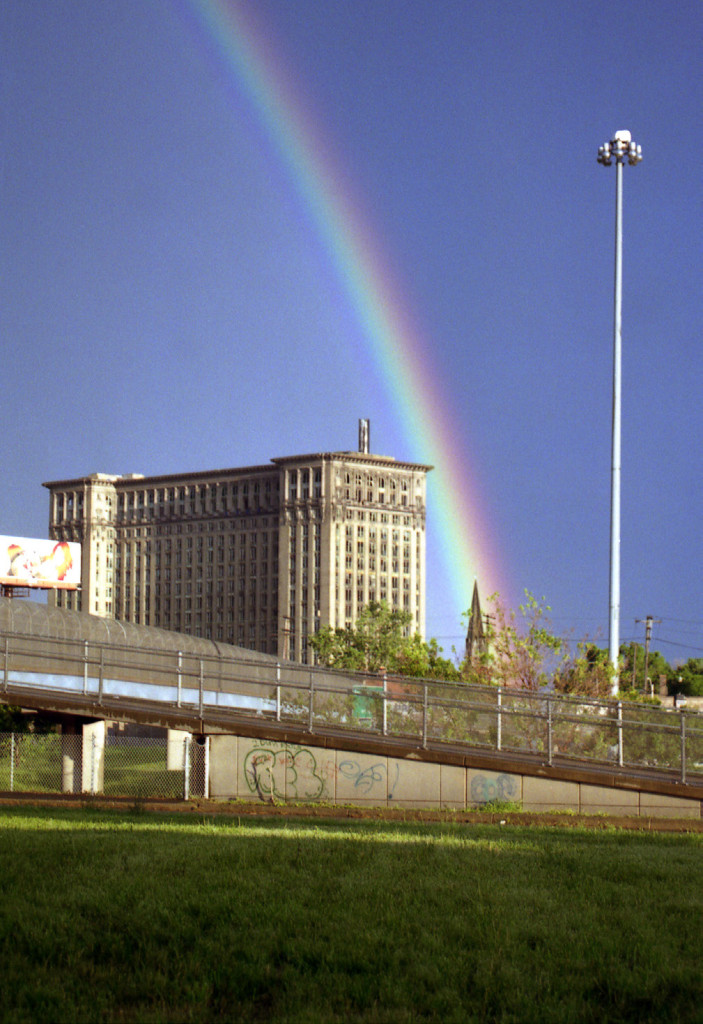PICTURES OF A CITY – SCRAPPERS
An Observation by Scott Hocking, 2004
The depopulation of Detroit City has created a gleaner’s goldmine, birthing a subculture of salvage like no other. While the suburban commuter sees an apparent ghost town from the expressway, these tens of thousands of vacant buildings have produced a viable niche for inner- city scavengers. Through my own hunting & gathering explorations I have encountered those who live in this invisible world and rely on this niche. Specifically, the homeless men who have stripped these urban ruins of any valuable scrap metal: the men who call themselves Scrappers.
Caught within a bizarre cycle for survival, Scrappers depend almost entirely on the abandonment and neglect of Detroit’s landscape. They have found ways to enter and remove metal from the majority of vacant homes and industries, often using only orphaned shopping carts to transport their spoils. By clearing pathways through debris, covering and bridging dangerous holes, and rigging rooftop pulleys, they have reaped and scavenged throughout the 140 square mile city. I have found evidence of scrapping within every building I’ve explored. They work constantly, barehanded with makeshift tools, pushing their loaded carts for miles to the nearest buyer. They earn just enough cash to survive, but not enough to escape their Sisyphean routine. They do not dare to protest when scrap buyers rig the scales, nor do they question a middleman who rips them off during a desperate midnight exchange. Due to the questionable legality of the acquisition and sale of this metal, the scrapper and buyer have trouble trusting each other. Regardless of what brought them to this lifestyle, they are workers, not beggars, who simply cannot afford to be junkies or alcoholics. Often solitary, they need to stay positive to survive. There is no time for rest and relaxation, no day off, especially throughout a harsh Detroit winter. They live day-to-day, without heat, electricity, running water, or any sense of security. Their shelters are collapsing structures of the past, soon to be demolished through gentrification. They are ghosts living in Detroit’s remaining haunts. They don’t exist.
It is hard to give an outsider a true understanding of how expansive Detroit’s wasteland is. In the past 50 years, the inner-city has lost over 1 million people. Skyscrapers became homeless hotels, houses became Devil’s Night bonfires, alleys became dumping grounds, vacant lots became prairies, and factories became greenhouses. Although scrapping exists in every city, Detroit’s abundant ruins have given rise to armies of scavengers and urban spelunkers (like me). There are easily hundreds of cart-pulling scrappers in the city.
In buildings such as the enormous Studebaker Corporation complex, scrappers have made pathways through a maze of detritus, often bridging over collapsed floors and roofs, and utilized crumbling walls as exit ramps for scrap. Scrappers have come and gone from this building for years, and most of what is left is useless to them. However, like most buildings that I explore, I owe much to these men for making such sites accessible and laying down somewhat safe paths. Along with Ford and Fisher Body, the Studebaker complex made Piquette Street the focus of Detroit’s budding auto industry; but you would never know it.
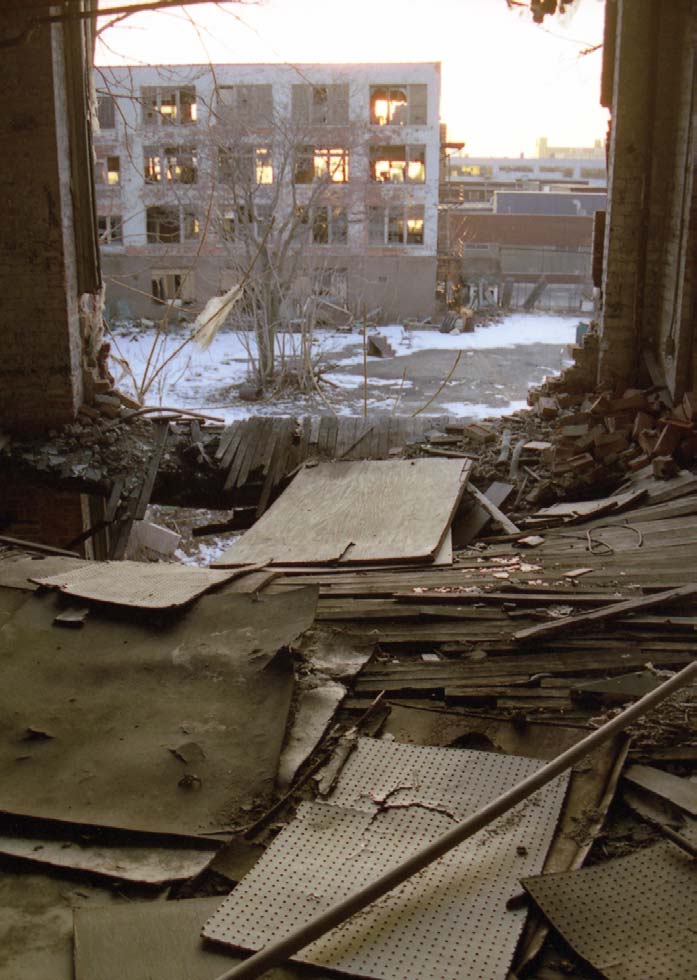
With this improvised ramp behind a demolished wall, a scrapper has created an exit from the Studebaker
Corporation complex. All images courtesy of Scott Hocking.
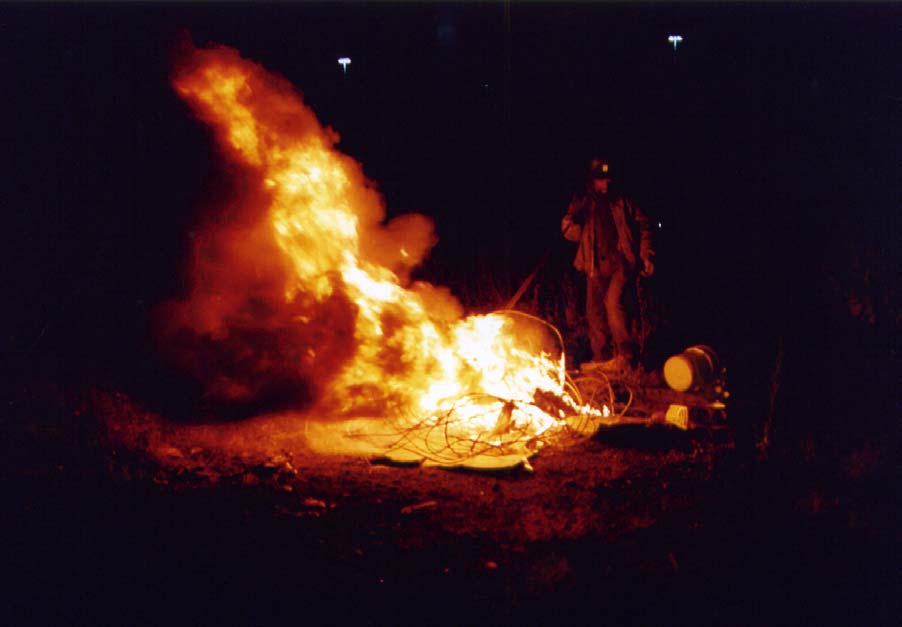
Scrapper "Country" burning the plastic coating off of copper cable.
Fisher Body Plant No. 21, 350 thousand square feet in size, is located just blocks away from my studio/home. Still as a mountain, it is another casualty along a street and railway that virtually defined the Motor City. I have been using it as inspiration and medium for years, and I know every corner of its vast expanse. Through my constant visitation, I have become friends with the permanent resident scrapper of this site, who goes by the name Country Boy. He continues to make it through the brutal winters, amassing furniture, clothing, blankets, and even a barbecue. Although others come and go through this building, this is Country’s home.
The vacant lots just east of the Fisher Body Plant are favorite locations for scrappers such as Country Boy and James to burn the plastic coating off of valuable copper wiring. With a surplus of shopping carts at their disposal, they ignite a cart full of cable, remove the smoldering metal, and haul it to a scrap-yard in another cart. This copper is the most precious metal scrapped on a regular basis. For example, high-quality copper wire (after burning) can fetch up to $0.75 a pound from an honest buyer, if one is lucky. Most often a scrapper will get the low-quality price (about $0.10 less per pound), depending on "reputation and business history" throughout the community, or will settle for the half-price of a midnight middleman. Unfortunately, acquiring 100 pounds of copper wire is rare, and definitely not to be found in any long abandoned buildings. Aluminum siding is far more plentiful, but it is worth roughly $0.45 per pound and weighs considerably less. Other metals such as nickel and brass are welcome, but hard to find, whereas inexpensive and extremely heavy cast iron is generally a last resort.
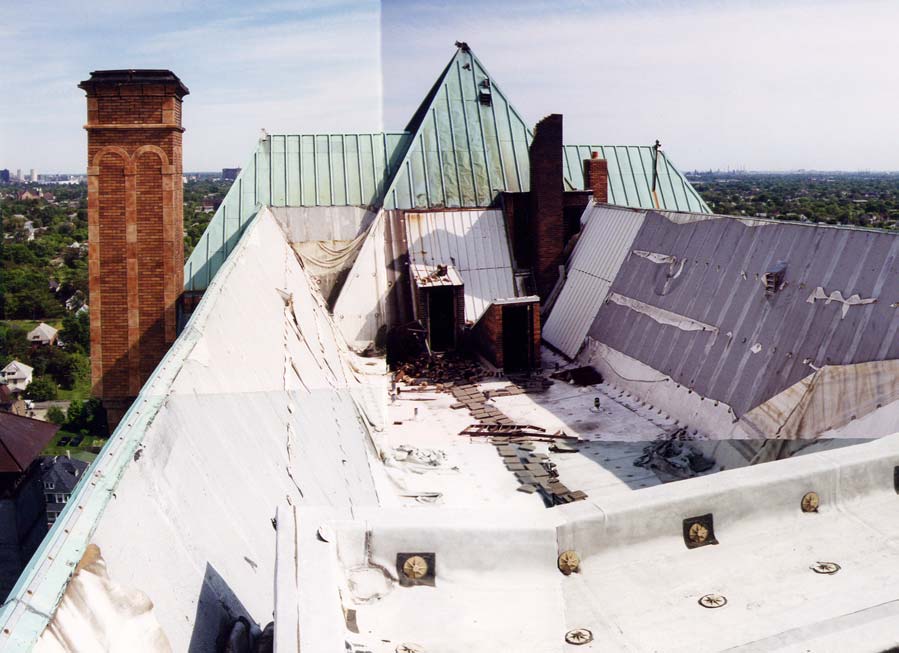
Stripped copper roof of the Lee Plaza high-rise.
Country Boy has been "pullin’ the cart" for 10 years now, perfecting his copper smelting technique. On this night he has "acquired" over a hundred pounds of plastic-coated copper wiring, which he ignites to burn away the plastic, reveal the high quality copper, and receive more cash. The highly toxic black smoke billowing from the flaming plastic is the least of Country’s worries. When he is satisfied with the process, he extinguishes the fire with water from a clogged sewer nearby. At this time of night, Country can take his scrap to a local ‘middleman’ who will pay him only about half price. Unfortunately, in this business, one cannot wait around until morning for the higher paying (and somewhat legitimate) scrap yards to open.
Scrapping is a competitive business. For example, The Lee Plaza is an abandoned high rise with a copper roof. Through a hole in a cinder block wall, scrappers have accessed an emergency stairwell and climbed 16 flights in utter darkness, to reach the precious roof. Hauling the heavy metal back down once is enough work for most, not to mention that the Plaza is no where near a scrap-yard. Although all the copper has been peeled from the inner roof, not even the most enterprising scrappers have risked scaling the peaks or outer slopes for fear of one slip. There is even a bed in one of the peaks.
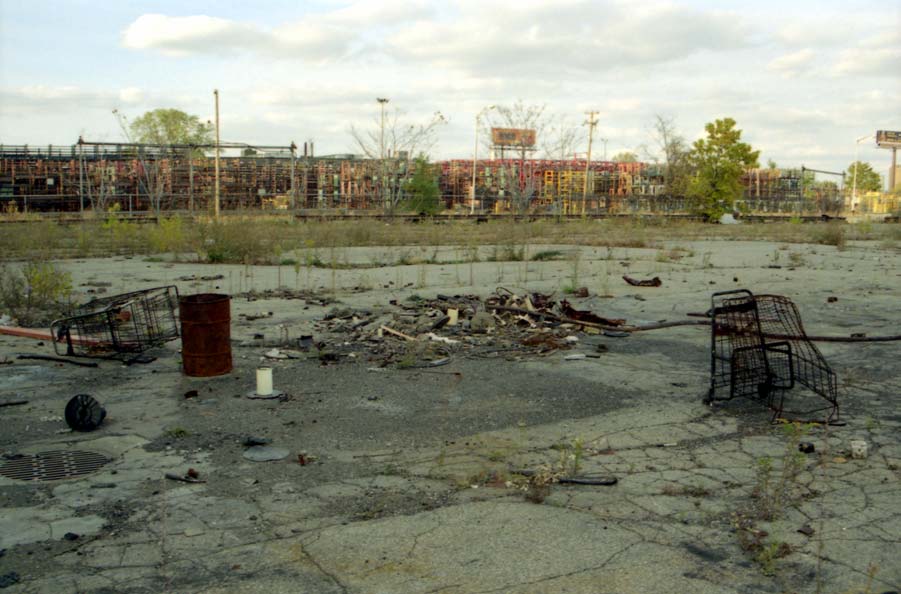
A scrapper's burning site.
In Detroit, as in many shrinking cities, there are many abandoned factories lining old railways. Along the east side of an overgrown section of Grand Trunk Railroad sits “the Old Mill,” where many scrappers live and work. Just west of the tracks there are many restaurants, shops, a fire station, and a bustling weekly marketplace. Still, the men who live and work here have done so for years, invisible and/or ignored. It is a good location, walking distance from the local scrap yard, with plenty of space to share. The large silos, which they call “the burners”, are perfect for smelting metals, which they do at night to avoid being noticed by their firefighting neighbors. Men like Jay, Stacey, and Slim have been resident scrappers at the mill for years.
The scrap-yard located near the Old Mill is frequented by local scrappers, who leave their carts behind once they’ve been paid. It is never a problem to find another cart. Although this method of scrap buying/selling is questionable, scrap-yards rarely deny their homeless customers. Plundering the same scrap-yard that buys one’s metal, however, is clearly risky. Still, this notion does not stop a scrapper named Slim from slipping through a rusted steel wall behind the scrap-yard, painted with an ironic “Have A Nice Day” smiley face.
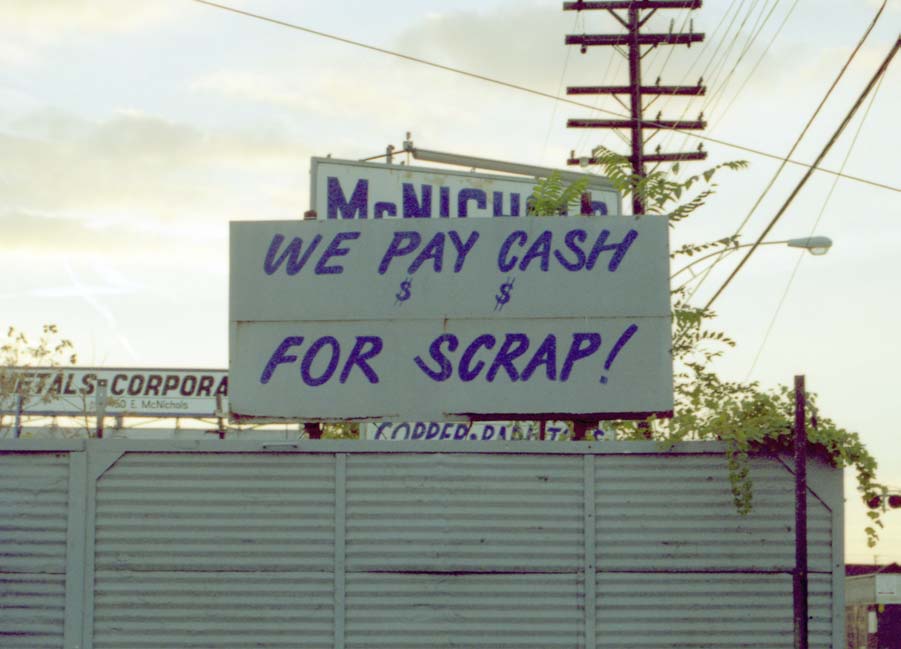
The sign "We pay cash for scrap!" attracts many scrappers. They know that they can make quick money without being hassled or having to answer any questions.
Attempts are made to stop the scrappers from scrapping from the scrap-yards. Often cameras or armed guards are employed to protect businesses from greedy scrappers. In most cases, it is not the solitary homeless scavenger who would risk a breaking and entering charge; rather, it is organized groups with vehicles for quick getaways. Nevertheless, scrappers are nocturnal opportunists, and no painted wall alone will stop them.
The scrap metal business is a lucrative one. The buyer entices the scrapper with “Cash For Scrap” signs that imply “no strings attached.” A homeless or impoverished scrapper knows that he/she can make quick money, no matter how he/she acquires their metal. In essence, the scrap-yard is selling their scrap to a bigger company, and so on, until the metal is shipped and reused, often overseas; So the worker bee that does the dirty work of excavating, hauling, and selling to a local scrap-yard is nothing more than cheap, untraceable labor for the top companies. Perhaps this is why scrappers go unnoticed by gun-toting law enforcement?

A scrapper named "D" removing the materials he has plundered on Devil's night.
If the remote inner regions of Detroit can be likened to a ghost town, here is a ghost: I caught this scrapping apparition on a night when there are literally hundreds of volunteers driving throughout the city in cars with little flashing roof-lights, looking for any suspicious activity. Devils Night (October 30th – Halloween’s Eve) has become such a legendary arson-ridden Detroit holiday, that the city has renamed it “Angels Night,” stepped up police and fire department patrols, and instilled strict curfews, hoping to curb crime. Yet, a scrapper named “D” pulls 20 ft. lengths of aluminum siding upon his noisy shopping cart at nearly 3 a.m., and no one notices, as if he is invisible. After developing these images, I think he may have been.
Detroit is changing. It appears that the Renaissance City may actually be in the midst of rebirth, which could be good, could be bad, depending on one’s perspective. Long abandoned landmarks, such as the Michigan Central Train Station, are being renovated, while derelict structures are being razed everyday. Scrappers are running out of old buildings to shop at, which is leading many of them to stealing from new construction sites instead. Their niche, once flourishing and new, now seems to be disappearing just as naturally as it appeared; and if the scrappers cannot adapt, will they disappear too? Many of them doubt that the city can ever be resurrected, and they say they’ve seen it all before. They can only wait and see, again.
> Taken from the English version of Shrinking Cities Volume 1: International Research text. Chapter 7 – Everyday Survival / Do It Yourself; Pages 470 – 477; Editor - Philipp Oswalt; Published by Hatje Cantz, 2005.
> Originally published in German as Schrumpfende Städte Band 1: Internationale Untersuchung, by Hatje Cantz, in 2004.
Addendum, Summer 2006
Just two weeks ago a scrapper was spotted on the roof of my studio, attempting to take a portion of my phone line. My neighbors flagged down a cop and he was caught quickly – they say he even had a gun, which he threw under a car... Hours later, when I got home and inspected the scene, I found that he had cut only the unused phone line that was raveled up and fastened with pigtails to the side of my building. The ‘gun’ he supposedly had was most likely wire cutters – but who knows. Regardless, what is certain is that scrapping is getting out of control. There are too many guys competing for scrap, and not enough places to get it anymore. Abandoned buildings are stripped bare, and being demolished. Even the 14 story Lee Plaza’s copper sheathed and formerly untouchable peaks, severely sloping to a certain death, have been gleaned. City issued garbage cans are routinely stolen and used as dollies. These younger groups of neo-scrappers are getting bolder and bolder – these guys are flat out thieves – and, apparently electricians. A Detroit Edison substation down the street from me was virtually stripped a month ago – and this place was up and running! One of the main reasons for this frenzy is the high price of copper right now – apparently directly connected to current military and weapons demands. It’s crazy when you think about it, where this scrap ends up.
So here I am, up on a ladder, removing the dangling phone line from the side of my building (finishing the job, really), and along comes Country Boy. He’s pulling a stolen city trashcan, full of scrap, and asking if I’ve got anything for him. I give him the phone line. Well, at least he asked...
> Originally published as addendum to “Scott Hocking: Pictures of a City – Scrappers,” in Dispatch Detroit, Volume 8, pages 34-51. Editor, Christine Monhollen. Doorjamb Press, 2007. Reprinted courtesy of Scott Hocking.
Epilogue
Spring 2013, Ten Years later
I’ve been living in the same building for twelve years now – my bed plopped down in the midst of what has become an indoor junkyard of dismantled installations. This is the longest I’ve ever lived in one place. And a lot has changed during that time. Detroit has been through an economic collapse, an auto industry bailout, a multi-faceted government corruption scandal, an emergency financial manager, and many other problematic storylines that make it easy for lifelong residents to remain jaded.
Yet, despite a continual drop in population, the inner city is gaining new residents from all over the world. It’s more diverse and integrated than I’ve ever known it. I can’t keep up with all of the new coffeehouses and start-up businesses. Community gardens are everywhere. The press and media consistently focus on Detroit’s transition from decaying auto capital into burgeoning artist Mecca. And there’s something intangibly different: an energy shift. Nostalgic memories of the heydays are fading away, but so are the rock-bottom memories of the last decades, and people are focusing on the future. It’s springtime as I write this; I’m surrounded by change.
Still, I can hear the cacophony of a metal-filled grocery cart being slammed over the potholes of my alley in the middle of the night – just as often as I did twelve years ago.
Same alley. Same scrappers. Same middleman. Well, not the same exact guys – except for Country, who passes by every now and then. But the routine is still there, and the metal is still coming from somewhere. Anywhere, in fact, they can find it. As I read my account from 10 years ago, much like reading an old diary, it’s striking how different some things are these days. Many of the buildings I listed are gone. If they’re still around, they are stripped clean, and they just aren’t squatted by scrappers anymore. You’ll find more urban explorers in abandoned buildings than homeless guys nowadays. In fact, so many people have flocked to photograph Detroit in the last decade, a new term was coined: ruin porn. Guys like Country are disappearing, too. Junkmen from a different time, I suppose. Younger men, hustling along, sometimes in groups, have replaced most of the older cart pullers. Crews with nice tools seem to play by a different set of rules than those old guys. Last winter, multiple bronze doors were stolen from the crypts of Detroit’s oldest cemeteries. Horrible. About a week ago, a scrapper died in a sewer, apparently killed while trying to rip out the wiring from beneath street lamps. That’s a new one. Though, going underground seems to be the next logical step, since sewer grates and manhole covers have been scrapped for years as well. Hell, my absolute piece-o-shit van was stolen for scrap last year. It feels a bit more like ‘anything goes,’ these days.
But I guess that’s the natural cycle at work. As the city grows and renews in many pockets, the scrappers continue to evolve with it. It’s a kind of balance. Maybe even a fight. One of the most telling examples of this dynamic happened while I was building a pyramid inside the long vacant Fisher Body Plant 21 (where else would one build a pyramid?). A group of scrappers were cutting down huge galvanized pipes from the ceiling using gas-powered saws, when suddenly the saws stopped, and all of the men got quiet. When I asked what was up, one of the guys pointed out that the entire building was currently being re-fenced by city workers. We were being fenced in. So... I got the hell out of there. The next day, I came back to see if I could still get inside FB21 and continue my project. Yep. I could. No problem. Not only did this band of gas-powered scrappers escape the newly fenced building with their metal – they scrapped the new chain link fence, too. Cut it off, rolled it all up, and drove away.
The more things change, the more they stay the same.
